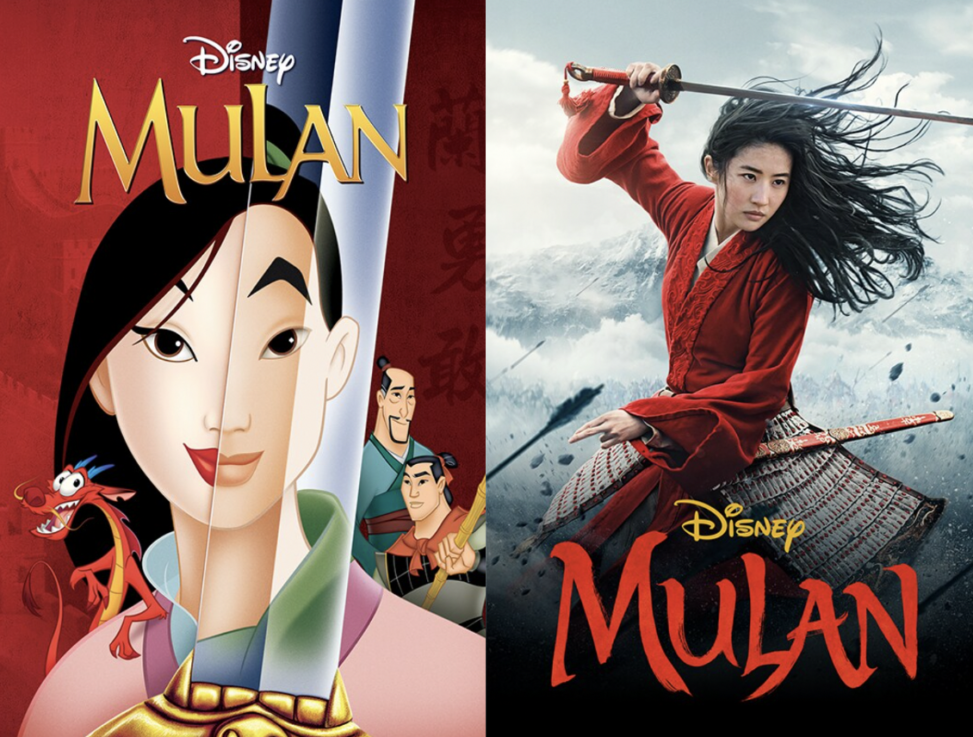The character of Mulan changed a lot from the animated Mulan (1998) to the live-action Mulan (2020). These changes show how society’s view on gender roles, identity, and representation have evolved. Mulan stands for the strength and bravery and challenges traditional ideas about women. Through this comparison, we can see how her character moved from the background to the spotlight and what that means for how society views identity.
Mulan shows the struggle for identity and breaking down gender barriers. In both movies, she dresses as man to take her father’s place in the army, highlighting courage and sacrifice. The animated film, however, has a lighter tone and includes a romance subplot, which can make Mulan seem less independent. The live-action version, on the other hand, focuses more on her inner struggles and her desire to honour her family.
Gender roles are a big part of Mulan’s story in both films. In the animated version, Mulan’s journey includes humuor and romance, which makes her seem less powerful. While she does prove herself in battle, her story is still linked to her relationship with men. In the live-action film, however, Mulan’s independence is more obvious, and there is no romance. This version focuses on her personal growth and bravery, encouraging viewers to see women as strong and capable on their own. According to Tan et al. (2021) this trend of showing strong female leads like Mulan reflects society’s growing support for gender equality and women’s empowerment in media.
Mulan’s race and cultural background are also important when analyzing her character. The animated film has been criticized for showing a Westernized view of Asian culture and reinforcing stereotypes. The live-action film tries to fix this by casting Asian actors and working with cultural experts to portray Chinese culture more accurately. According to Zhou et al (2022), this approach shows a larger trend toward respect and inclusion in films: “The live-action adaptation was an effort to enhance the cultural depth of Mulan, offering a representation that feels more authentic to Chinese heritage.”
The way Mulan’s abilities are shown differs between the two films. In the animated version, her skills are sometimes exaggerated for laughs, which make her seem less serious. The live-action film, however, treats her abilities with respect, focusing on her training and determination. This portrayal giver her more power and shows that women can be strong and graceful without relying on humuor. According to Yang (2022), Mulan’s physical and mental strength are shown as serious parts of her identity rather than just entertainment in the live-action film.
The changes in Mulan’s character create new ideas about gender roles and identity. In the live-action film, Mulan is depicted with a strong sense of independence and inner strength, encouraging viewer to accept their uniqueness and challenge old stereotypes. This version promotes a more inclusive view of femininity, where women are more valued for their individuality and abilities beyond traditional role. This change has both positive and negative effects. On one hand, it empowers viewers, especially women and young girls to challenge social norms and build self-confidence. Seeing a character who embraces her strengths can inspire audiences to feel that they, too, can succeed on their own terms.
However, this new portrayal also introduces potential pressures. As the film celebrates Mulan’s physical ability and courage, some viewers may feel an expectation to embody similar traits, which may not align with their own personalities or circumstances. According to Wang (2022), this can lead to stress or feelings of unequalness if they feel they fall short of these new ideals. Moreover, while Mulan’s character is meant to be role model, the high standards of strength and resilience she sets can unintentionally pressure viewers to excel in areas that might not reflect their true desire. This tension highlights the complexity of shifting representation, where the push for empowerment may sometimes create unintended burdens for audiences who are still navigating their own identities.
Both versions of Mulan reflect changing social attitudes. The animated film was made when gender roles were less questioned than they are today. The live-action adaptation, however, has faced criticism, suggesting that our understanding of identity and representation is still growing. (Yang, 2022)
Comparing Mulan in the animated film (1998) and live-action (2020) films shows how her character has changed, especially in terms of gender, race, and ability. Mulan’s journey from the background to spotlight reflects a larger cultural shift toward more complex and respectful portrayals of women in media. While both films have different perspectives, the live action version focuses more on personal strength, cultural respect, and the complexity of identity. Mulan serves as a reminder of the importance of inclusion and celebrating each person’s identity.
Bibliography:
Wang, Zhuoyi. 2022. “From Mulan (1998) to Mulan (2020): Disney Conventions, Cross-Cultural Feminist Intervention, and a Compromised Progress” Arts 11, no. 1: 5. https://doi.org/10.3390/arts11010005
Manaworapong, P., Bowen, N.E.J.A. Language, gender, and patriarchy in Mulan: a diachronic analysis of a Disney Princess movie. Humanit Soc Sci Commun 9, 224 (2022). https://doi.org/10.1057/s41599-022-01244-y
Chen, Rui, Zhiyi Chen, and Yongzhong Yang. 2021. “The Creation and Operation Strategy of Disney’s Mulan: Cultural Appropriation and Cultural Discount” Sustainability 13, no. 5: 2751. https://doi.org/10.3390/su13052751
Yang, Shuang. “Cultural Representation in Modern Cinema: A Study of Disney’s Live-Action Mulan.” In Proceedings of the 2022 International Conference on Humanities and Social Science Research (ICHSSR 2022), 125-975067. Atlantis Press, 2022. https://www.atlantis-press.com/proceedings/ichssr-22/125975067.
Screen grab from Disney:
https://movies.disney.com/mulan
https://movies.disney.com/mulan-2020


MJ Ponte
Last source link is showing up as not available. I talked to Professor about it and showed her evidence about this glitch. I’m attaching another link to the same source for the person that will critique my work for you to open.
PS. This means that my in-text citation with (Yang, 2022) would be (Chen, Chen, and Ruan, 2022).
Chen, Siyang, Yue Gao, Junhong Ruan. “Barriers to Disney Live-Action Movie Mulan: A Study Among Chinese Audience’s Attitude Towards Mulan (2020).” In Proceedings of the 2022 International Conference on Humanities and Social Science Research (ICHSSR 2022), 125-975067. Atlantis Press, 2022. 10.2991/assehr.k.220504.089
cnessman
Hi MJ,
Your essay is very well completed! I believe that you did a good job comparing the two variations of Mulan and ways that her character developed from the cartoon to the live action film. Your point about how the first movie incorporates a love interest, which subtly undercuts her power despite her courageous efforts to protect her family and community. The second move focuses on “personal growth and bravery” providing a strong role model for women, focusing on independence and resilience (Ponte). I found this point effectively shows how the incorporation of romance will distract from Mulan’s power and strength. I believe you analyzed the two characters very well by adding quotes and fully describing Mulan’s stories. Your essay discusses several key points. Gender roles is an important message of “growing support for gender equality, and women’s empowerment” (Ponte). Your next point emphasizes physical and mental abilities and the differences between the two films. The first film showed her physicality as more entertainment, whereas the live action movie presented strength and empowerment. Additionally, your next point talks about Mulan’s identity and how she was able to break through stereotypical barriers in both films. Your essay contributed several important messages for how audiences view and respond to the differences between the two films. I believe you used your sources well and incorporated them into the flow of the text seamlessly. Each citation added depth and critical quotes to your analysis. You made many really good points and brought to light several important ideas; my only advice is to focus more on the points you believe are the most important messages for the reader. Maybe amalgamate some smaller paragraphs together and take more time to emphasize the importance of a few points like the cultural representation or gender roles. Finally, the two images you chose fully demonstrated what your piece would entail and provided the reader with a side-by-side representation of the character through time. Very well done MJ!!
– Cali N.